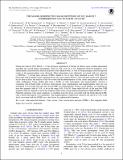The major geoeffective solar eruptions of 2012 March 7: comprehensive Sun-to-Earth analysis
Abstract
During the interval 2012 March 7-11 the geospace experienced a barrage of intense space weather phenomena including the second largest geomagnetic storm of solar cycle 24 so far. Significant ultra-low-frequency wave enhancements and relativistic-electron dropouts in the radiation belts, as well as strong energetic-electron injection events in the magnetosphere were observed. These phenomena were ultimately associated with two ultra-fast (>2000 kms-1) coronal mass ejections (CMEs), linked to two X-class flares launched on early 2012 March 7. Given that both powerful events originated from solar active region NOAA 11429 and their onsets were separated by less than an hour, the analysis of the two events and the determination of solar causes and geospace effects are rather challenging. Using satellite data from a flotilla of solar, heliospheric and magnetospheric missions a synergistic Sun-to-Earth study of diverse observational solar, interplanetary and magnetospheric data sets was performed. It was found that only the second CME was Earth-directed. Using a novel method, we estimated its near-Sun magnetic field at 13R⊙ to be in the range [0.01, 0.16] G. Steep radial fall-offs of the near-Sun CME magnetic field are required to match the magnetic fields of the corresponding interplanetary CME (ICME) at 1 AU. Perturbed upstream solar-wind conditions, as resulting from the shock associated with the Earth-directed CME, offer a decent description of its kinematics. The magnetospheric compression caused by the arrival at 1 AU of the shock associated with the ICME was a key factor for radiation-belt dynamics.
Citation
Patsourakos , S , Georgoulis , M K , Vourlidas , A , Nindos , A , Sarris , T , Anagnostopoulos , G , Anastasiadis , A , Chintzoglou , G , Daglis , I A , Gontikakis , C , Hatzigeorgiu , N , Iliopoulos , A C , Katsavrias , C , Kouloumvakos , A , Moraitis , K , Nieves-Chinchilla , T , Pavlos , G , Sarafopoulos , D , Syntelis , P , Tsironis , C , Tziotziou , K , Vogiatzis , I I , Balasis , G , Georgiou , M , Karakatsanis , L P , Malandraki , O E , Papadimitriou , C , Odstrčil , D , Pavlos , E G , Podlachikova , O , Sandberg , I , Turner , D L , Xenakis , M N , Sarris , E , Tsinganos , K & Vlahos , L 2016 , ' The major geoeffective solar eruptions of 2012 March 7: comprehensive Sun-to-Earth analysis ' , Astrophysical Journal , vol. 817 , no. 1 , 14 . https://doi.org/10.3847/0004-637X/817/1/14
Publication
Astrophysical Journal
Status
Peer reviewed
ISSN
0004-637XType
Journal article
Collections
Items in the St Andrews Research Repository are protected by copyright, with all rights reserved, unless otherwise indicated.

